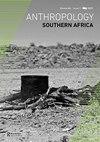Covid, cohesion, connection, care: thoughts on Connected Lives
IF 0.9
3区 社会学
Q3 ANTHROPOLOGY
引用次数: 0
Abstract
is not unusual among the teenage parents themselves, as some of the other case studies suggest. The image of the caring teen father is a foreign one, even to many academic pieces on fatherhood and teenage parenting. Alison Swartz’s piece “Saving Face” (Case Study 4.2) further explores how fatherhood is important to the masculine self-image of teenaged fathers through the tale of Luyanda, who found he could perform a masculinity based on his virility through the “proof” of his child and his responsibility towards her. He contrasted this with his earlier experiences of masculinity within a gang and partying. For him, his new experience of masculinity sat as comfortably within his connection to Xhosa masculinity as his performative male strength and power as a gang member, as this essential “maleness” now came through in the shouldering of responsibility towards his child and girlfriend as a provider. When his girlfriend, Andiswa, sought the company of other men because of his inability to provide the kind of life she wanted, it was not only his masculine pride that was injured but his emotional well-being too. However, he remained determined to be a father figure for his daughter, the essence of masculinity to him (given the death of his own father). These case studies, and the accompanying theorisation, work to destabilise stereotypes which flourish inside and outside of academia. The idea of masculinity is reconceived in the plural, as masculinities, a multiplicity of affective experiences held by men as varied as their understandings of what it is to be a man. It is worth noting that not all forms of masculinity, or even its forms in Southern Africa, have been charted here, and there are some obvious omissions (such as queer, trans and gay fatherhood, so-called “upper-class” experiences of masculinity and white, Indian and other apparent racialised or cultural experiences of maleness). This is a striking gap in a conversation about masculinities. As Mkhwanazi and Manderson acknowledge, the scope of this book does not allow for a more extensive interrogation of masculinity but does reveal spaces for further academic enquiry. Connected Lives is both fascinating and well written. It is an excellent source for academics and students in the social sciences and those members of the public who are concerned with issues of public and community health, anthropology and sociology, as well as demographic studies more broadly.Covid,凝聚力,连接,关怀:关于互联生活的思考
正如其他一些案例研究表明的那样,这在青少年父母中并不罕见。充满爱心的青少年父亲的形象是外来的,甚至对许多关于父亲和青少年养育的学术文章来说也是如此。Alison Swartz的作品“Saving Face”(案例研究4.2)通过Luyanda的故事进一步探讨了父亲身份对青少年父亲的男性自我形象的重要性,Luyanda发现他可以通过他孩子的“证明”和他对她的责任来表现他的男子气概。他将这与他早年在帮派和派对中表现出的男子气概进行了对比。对他来说,他对男子气概的新体验与他与科萨男子气概的联系一样舒适,就像他作为一名帮派成员表现出的男性力量和权力一样,因为这种基本的“男子气概”现在通过承担抚养孩子和女朋友的责任而体现出来。当他的女友安德斯瓦(Andiswa)因为他无法提供她想要的那种生活而寻求其他男人的陪伴时,不仅他的男性自豪感受到了伤害,他的情感健康也受到了伤害。然而,他仍然决心成为女儿的父亲,对他来说,这是男子气概的本质(考虑到他自己的父亲去世)。这些案例研究,以及伴随的理论化,努力打破学术界内外盛行的刻板印象。男子气概的概念以复数形式被重新认识,作为男子气概,男人所拥有的多种情感体验,就像他们对什么是男人的理解一样多种多样。值得注意的是,并非所有形式的男性气质,甚至在南部非洲的男性气质,都在这里被绘制出来,而且有一些明显的遗漏(比如酷儿、变性人和同性恋父亲,所谓的“上层阶级”男性气质经历,以及白人、印度人和其他明显的种族化或文化化的男性气质经历)。这是关于男子气概的对话中一个显著的空白。正如姆赫瓦纳齐和曼德森承认的那样,这本书的范围不允许对男性气质进行更广泛的探讨,但确实为进一步的学术研究提供了空间。《互联生活》既引人入胜,又写得很好。对于社会科学领域的学者和学生以及关注公共和社区卫生、人类学和社会学以及更广泛的人口研究问题的公众来说,它是一个极好的资料来源。
本文章由计算机程序翻译,如有差异,请以英文原文为准。
求助全文
约1分钟内获得全文
求助全文

 求助内容:
求助内容: 应助结果提醒方式:
应助结果提醒方式:


